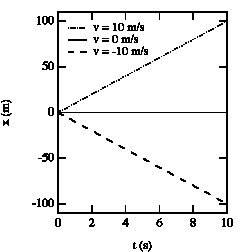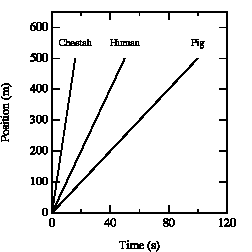
Figure 1. One-dimensional position.
For a given problem, the origin can be chosen at whatever point is convenient. For example, the position of the object at time t = 0 is often chosen as the origin. The position of the object will in general be a function of time: x(t). Figure 2.2. shows the position as a function of time for an object at rest, and for objects moving to the left and to the right.

Figure 2. x vs. t graphs for various velocities.
For a given problem, the origin can be chosen at whatever point is convenient. For example, the position of the object at time t = 0 is often chosen as the origin. The position of the object will in general be a function of time: x(t). Figure 2.2. shows the position as a function of time for an object at rest, and for objects moving to the left and to the right.

Figure 2. x vs. t graphs for various creatures.
An object that changes its position has a non-zero velocity. The average
velocity ![]() of an object during a specified time interval is defined
as:
of an object during a specified time interval is defined
as:
![]()
If the object moves to the right, the average velocity is positive.
An object moving to the left has a negative average velocity. It is clear
from the definition of the average velocity that ![]() depends only on
the position of the object at time t = t1 and at time t = t2. This is nicely
illustrated in the following example.
depends only on
the position of the object at time t = t1 and at time t = t2. This is nicely
illustrated in the following example.
- You drive a beat-up pickup truck down a straight road for 5.2 mi at
43 mi/h, at which point you run out of fuel. You walk 1.2 mi farther, to
the nearest gas station, in 27 min (= 0.450 h). What is your average velocity
from the time you started your truck to the time that you arrived at the
station ?
The pickup truck initially covers a distance of 5.2 miles with a velocity of 43 miles/hour. This takes 7.3 minutes. After the pickup truck runs out of gas, it takes you 27 minutes to walk to the nearest gas station which is 1.2 miles down the road. When you arrive at the gas station, you have covered (5.2 + 1.2) = 6.4 miles, during a period of (7.3 + 27) = 34.3 minutes. Your average velocity up to this point is:

Suppose you next carry the fuel back to the truck, making the round-trip in 35 min. What is your average velocity for the full journey, from the start of your driving to you arrival back at the truck with the fuel ?
It takes you another 35 minutes to walk back to your car. When you reach your truck, you are again 5.2 miles from the origin, and have been traveling for (34.4 + 35) = 69.4 minutes. At that point your average velocity is:

After this episode, you return back home. You cover the 5.2 miles again in 7.3 minutes (velocity equals 43 miles/hour). When you arrives home, you are 0 miles from your origin, and obviously your average velocity is:

The average velocity of the pickup truck which was left in the garage is also 0 miles/hour. Since the average velocity of an object depends only on its initial and final location and time, and not on the motion of the object in between, it is in general not a useful parameter. A more useful quantity is the instantaneous velocity of an object at a given instant. The instantaneous velocity is the value that the average velocity approaches as the time interval over which it is measured approaches zero.
![]()
Note the similarity between the definition of the average velocity and the definition of the average acceleration. A positive acceleration is in general interpreted as meaning an increase in velocity. However, this is not correct. From the definition of the acceleration, we can conclude that the acceleration is positive if
![]()
This is obviously true if the velocities are positive, and the velocity is increasing with time. However, it is also true for negative velocities if the velocity becomes less negative over time.
A special type of motion is motion with a constant acceleration. Objects falling under the influence of gravity are one example of objects moving with constant acceleration. The acceleration due to gravity (g) equals 9.8 m/s2. In general, objects on which a constant force is acting will show a motion with constant acceleration. For such a motion, the velocity will show a linear dependence on time, and the position will show a quadratic dependence on time
![]()
![]()
where x0 and v0 are the position and the velocity of the object at time t = 0 s.